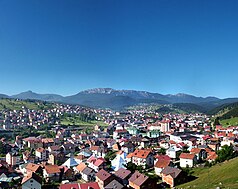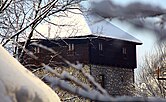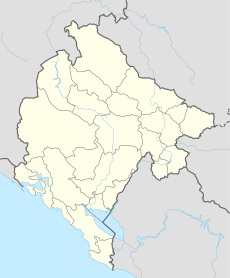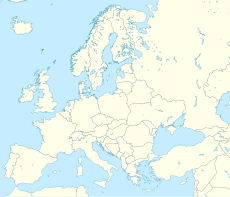Rožaje
Rožaje
Рожаје Rozhaja | |
|---|---|
Town and municipality | |
View of Rožaje | |
| Coordinates: 42°50′N 20°10′E / 42.84°N 20.16°E | |
| Country | Montenegro |
| Region | Northern |
| Municipality | Rožaje |
| Settlements | 66 |
| Government | |
| • Type | Mayor-Assembly |
| • Mayor | Rahman Husović (BS) |
| Area | |
• Town and municipality | 432 km2 (167 sq mi) |
| Elevation | 1,109 m (3,638 ft) |
| Population (2023[1]) | |
| • Rank | 7th in Montenegro |
| • Density | 53/km2 (140/sq mi) |
| • Urban | 13,608 |
| • Rural | 11,639 |
| • Municipality | 25,247 |
| Demonym | Rožajci |
| Time zone | UTC+1 (CET) |
| • Summer (DST) | UTC+2 (CEST) |
| Postal code | 84310 |
| Area code | +382 51 |
| ISO 3166-2 code | ME-17 |
| Car plates | RO |
| Climate | Cfb |
| Website | www |
Rožaje[a] (Montenegrin: Рожаје,[b] pronounced [rɔ̂ʒajɛ]; Albanian: Rozhaja, Albanian pronunciation: [roʒajə]) is a town located in the Northern Region of Montenegro, situated along the Ibar river. The town is the cultural center of the Bosniaks in Montenegro.
As of 2023, the town has a population of 13,608 inhabitants.
Surrounded by hills to its west and mountains to its east (notably Mount Hajla), the town is divided in half by, and contains the source of the river Ibar, which gives its name to the local sports clubs FK Ahmad, KK Ibar and OK Ibar. Rožaje is the centre of the Rožaje Municipality within the 25 municipalities of Montenegro.
Rožaje annually celebrates its foundation day on September 30.[2]
History
[edit]Rožaje was first settled in antiquity by the Illyrians. Evidence of this Illyrian settlement is located on Brezojevica Hill. Later, during the migration of the Slavs, Slavs settled in the area.[3] Rožaje was first mentioned in 1571 and 1585. The settlement surrounding the then fort was called Trgovište, which it was called until 1912.[citation needed]
During the Ottoman Empire's reign over Montenegro, the Sultan Murat II Mosque was constructed in the city in the 1500s, which also contains the turbe of the sultan's body. It is considered to be the oldest mosque in the entire city.
In 1700, after the Great Serb Migration, the Albanian clans of the Kelmendi and Kuçi and other tribes like the Shkreli of Rugova established themselves in the region of Rožaje and the neighboring town of Tutin in Serbia. The Shala, Krasniqi, and Gashi also moved in the region.[4][5][6]
In 1797, the Ganić kula, a defensive tower was built from the Muslim side of the Kuči, as they supported the Muslim authority and cultural practices, was built. Nowadays, the tower is currently the town's museum.[7]
During World War I, the army of the Kingdom of Montenegro captured the city in 1912 from the Ottoman Empire, during the First Balkan War. Within this time, the Montenegrin Army under King Nikola quickly sought to Serbianize the population, to reduce threats of invasions or uprisings by the Albanian locals. It was officially ceded to Montenegro following the Treaty of London in 1913 that ended the war. In 1917, the local Albanian qadi Bajram Balota organised a force of irregulars in the territory held by Austria-Hungary in Montenegro around Berane and Rožaje, with his soldiers and allies persecuting and killing Orthodox Montenegrins. His movement was dissolved following a defeat by Austro-Hungarian soldiers on June 18, 1918.[8] In 1919, after the war, Rožaje was one of the main cities that participated in an Albanian revolt, which later came to be known as the Plav Rebellion (Montenegrin: Plavska Pobuna), rising up together with the Plav and Gusinje districts and fighting against the inclusion of Sandžak in the Kingdom of Serbs, Croats and Slovenes.[9][10][11] An estimated 700 Albanians were killed in Rožaje by the Serbian army when the rebellion was quelled.[12] These events resulted in a large influx of Albanians migrating to Albania.[13][14]
During World War II, the city has seen conflict between the Yugoslav Partisans, the Chetniks, the Sandžak Muslim Militia, and the Albanian Vulnetari. Mullah Jakup Kardović, who would end up being a prominent commander of the Militia and would participate in the Battle for Novi Pazar, came from the village of Biševo, which is 4–5km away from the city.
After World War II, the city of Rožaje became a part of SR Montenegro, which was ultimately a part of the SFR Yugoslavia. Within this time period, the municipality of Rožaje did not exist, as it was a part of the Ivangrad (now Berane) municipality at the time. During the 1960s, the authorities established the Gornji Ibar company, which was a woodworking/lumber/furniture assembling factory. At one point, the company employed more than 53% of the entire city. It expanded the economic status of the city, and became a focal point for woodworking within the region.
In 1992, the Gornji Ibar company was liquidated and subsequently went out of business, which left the city in economic turmoil.
During the Bosnian War, the Bosniaks of Foča who managed to escape the massacre that happened in the area resettled in Rožaje.[15]
During the Kosovo War in 1999, around 1,000 ethnic Albanians that also managed to escape the war settled in the south of Rožaje. They were mostly from the regions of Drenica and Mitrovica.[16]
In 2018, a replica of the Sebilj in Sarajevo has been completed and is currently displayed in the town's main square.[17]
Administration
[edit]City Assembly
[edit]| Party/Coalition | Seats | Local government | |
|---|---|---|---|
| Bosniak Party | 21 / 34
|
Government | |
| DPS, SDP, SD, LP | 8 / 34
|
Opposition | |
| United Reform Action | 2 / 34
|
Opposition | |
| SPP | 2 / 34
|
Opposition | |
| Independent | 1 / 34
|
Opposition | |
Geography
[edit]The municipality is situated on large hills, with the mountains Hajla, Mokra Gora, Ahmica, Krstac, Žljeb, Štedim and Turjak to its east and southeast. Those mountains belong to the northern part of the Accursed Mountains range. The Ibar River flows through it and coniferous forests cover most parts of the unsettled region. Thanks to the river, there are abundant sources of large forests, arable pastures and meadows within the municipality. During the winter months, the surrounding mountains experience a major cold front, with snow and ice being very common within the city, and the municipality itself. The Koppen Climate has been recorded as Cfb, or a marine climate. The city stands at around 1,014m or 3,326ft above sea level.
Demographics
[edit]| Year | Pop. | ±% |
|---|---|---|
| 1948 | 1,461 | — |
| 1953 | 1,813 | +24.1% |
| 1961 | 2,765 | +52.5% |
| 1971 | 5,327 | +92.7% |
| 1981 | 7,336 | +37.7% |
| 1991 | 8,828 | +20.3% |
| 2003 | 9,121 | +3.3% |
| 2011 | 9,567 | +4.9% |
| 2023 | 13,608 | +42.2% |
| Population size may be affected by changes in administrative divisions. | ||
Rožaje is the administrative centre of the Rožaje municipality, which has a total of 25,247 residents. The town of Rožaje itself has a population of 13,608 in 2023.
There are 2 major neighbourhoods within the municipality, Ibarac, and Bandžovo Brdo. Ibarac is split between Lijeva Obala Ibar and Desna Obala Ibar.
Ethnic groups
[edit]In the 2023 census, 84.66% declared themselves as Bosniaks. Rožaje is considered to be the centre for the Bosniak community of Montenegro. Bosniaks form the majority in both the town and the municipality itself.
Ethnic Albanians, have been present within the city, as well as the outskirts, especially villages that are close to the border of Kosovo (such as Dacići, Balotići, Plumci, Bać, Besnik, etc). They enjoy and support mutual relations with the Bosniaks and other ethnicities within the city and have also become an integral part of Rožaje's society. The current population of Albanians living in Rožaje Municipality is 1,176, forming 5.07% of the total population in 2023. The Albanians of this region speak in the Gheg dialect of the Albanian language and are majority Muslims.
Albeit very small in terms of population size, the Serbs (2.56%) have also lived in Rožaje for some time, and usually have amicable relations with the other ethnic communities in the city. Bijela Crkva is one of the only Serb-majority villages within the municipality.
3.76% of the total population in Rožaje declared themselves as Montenegrins.
Languages
[edit]Montenegrin, Serbian, Bosnian, and Croatian are mutually intelligible as standard varieties of the Serbo-Croatian language. Like most cities and areas belonging to the Sandžak region, they speak a dialect of the Bosnian language known as "Bošnjački", with the total amount of speakers declared at 74.05%, as it is the most widely-spoken language in the city. The second most spoken language in the city is Montenegrin (16.55%), Albanian speakers amount to 4.34%, and Serbian speakers amount to 3.02% of the population. A total of 1.82% of the population have not declared their native, or primarily-spoken language.[18]
Religion
[edit]As Rožaje is one of the only Muslim-majority municipalities, it has several mosques within the city, two notable ones being the Kučanska Džamija and the other being the Sultan Murat II mosque. However, there are 2 Orthodox churches that can be found in the municipality, with the ruined Ružica church and Gospođin vrh church allegedly built by the wife of the Serbian king Uroš I.
Rožaje is predominantly a Muslim-majority city, comprising 96.52% of the total population. The population of Rožaje is composed largely of Bosniaks, who predominantly adhere to Sunni Islam. Historically, Islam has played a significant role in shaping the cultural and social fabric of the town. Mosques are prominent landmarks in the municipality, serving as places of worship and community gathering. However, Rožaje is also characterized by religious diversity. Alongside Islam, there are minority populations practicing Orthodox Christianity, amounting to 3.06% of the total population.
Transport
[edit]Rožaje is situated on the main road connecting Montenegro with Kosovo, known as the Rožaje-Kula-Peć road (Kula being the border post between Montenegro and Kosovo on both sides). It also has a link with Novi Pazar in Central Serbia, through the IB-22 Highway (otherwise known as the Ibarska magistrala), which is the main regional road that connects Montenegro with Serbia. It is also connected to the rest of Montenegro by a two-laned highway via Berane, which is some 30 km (19 mi) in distance.
The nearest airport is the Pristina International Airport Adem Jashari in Pristina, Kosovo which is 116 km (72 mi) away, compared to Podgorica Airport which is about 180 km (110 mi) away, and has regular flights to major European destinations annually. However, due to the opening of the Bar-Boljare motorway in November of 2021, the time from getting to Rožaje from Podgorica has greatly reduced, and is slowly becoming more preferred over the earlier option for most of the diaspora from other countries.
International relations
[edit]Twin towns — Sister cities
[edit]Gallery
[edit]-
Ibar river canyon
-
Hajla near Rožaje
Notable People
[edit]- Ernad Sabotic (born 1979) - footballer
Notes
[edit]Sources
[edit]References
[edit]- ^ "Preliminary results of the 2023 Census of Population, Households, and Dwellings". Monstat. Retrieved 25 January 2024.
- ^ "Skupstina Crne Gore". September 2019.
- ^ "History of Rožaje". Retrieved 28 June 2013.
- ^ Mušović, Ejup (1985). Tutin i okolina. Serbian Academy of Science and Arts. p. 27.
- ^ The Tribes of Albania,: History, Culture and Society. Robert Elsie. 24 April 2015. p. 104. ISBN 9780857739322.
- ^ Kaser, Karl (1992). Hirten, Kämpfer, Stammeshelden: Ursprünge und Gegenwart des balkanischen Patriarchats. Böhlau Verlag Wien. p. 163. ISBN 3205055454.
- ^ Darren (Norm) Longley; Rough Guides (30 March 2009). The Rough Guide to Montenegro. Penguin. p. 156. ISBN 978-1-4053-8425-4. Retrieved 10 May 2012.
- ^ Furat, Ayşe Zişan; Er, Hamit (2012-11-15). Balkans and Islam: Encounter, Transformation, Discontinuity, Continuity. Cambridge Scholars Publishing. ISBN 978-1-4438-4283-9.
- ^ Morrison 2018, p. 56.
- ^ Giuseppe Motta, Less than Nations: Central-Eastern European Minorities after WWI, Volume 1 , Cambridge Scholars Publishing, 2013, p. 11
- ^ Klaus Roth, Ulf Brunnbauer, Region, Regional Identity and Regionalism in Southeastern Europe, Part 1, LIT Verlag Münster, 2008, p. 221
- ^ Morrison 2018, p. 21.
- ^ Mulaj, Klejda (2008-02-22). Politics of Ethnic Cleansing: Nation-State Building and Provision of In/Security in Twentieth-Century Balkans. Lexington Books. p. 33. ISBN 978-0-7391-4667-5.
- ^ Banac, Ivo (2015-06-09). The National Question in Yugoslavia: Origins, History, Politics. Cornell University Press. pp. 298 snippet view. ISBN 978-1-5017-0194-8.
- ^ Human Rights Watch, 2006-Genocide, war crimes, and crimes against humanity: a topical digest of the case law of the International Criminal Tribunal for the former Yugoslavia
- ^ MONTENEGRO: ROZAJE: KOSOVO REFUGEE CRISIS LATEST, retrieved 2023-01-01
- ^ "Simbol Sarajeva u Sandžaku: Nakon Pazara, Sjenice sebilj ukrašava i Rožaje FOTO/VIDEO". AKOS (in Bosnian). Retrieved 2019-01-31.
- ^ "Popis stanovništva, domaćinstava i stanova, 2023. godine" (PDF).
- ^ "Popis stanovništva, domaćinstava i stanova, 2023. godine" (PDF).
- ^ "Bratimljenje" (PDF). database.uom.me (in Montenegrin). Zajednica opština Crne Gore. January 2013. p. 33. Retrieved 2019-12-29.
- ^ "Odluka o bratimljenu opštine Rožaje sa opštinom Kutahya" (PDF). rozaje.me (in Montenegrin). Rožaje. 2015-04-13. Retrieved 2022-09-27.
Bibliography
[edit]- Morrison, Kenneth (2018). Nationalism, Identity and Statehood in Post-Yugoslav Montenegro. Bloomsbury Publishing. ISBN 9781474235204.











